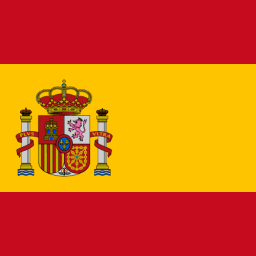Podia vs Thinkific (2025): An even better alternative
We looked at how Podia and Thinkific compare to each other (and to Esmerise) to help you decide what is the best platform for you.
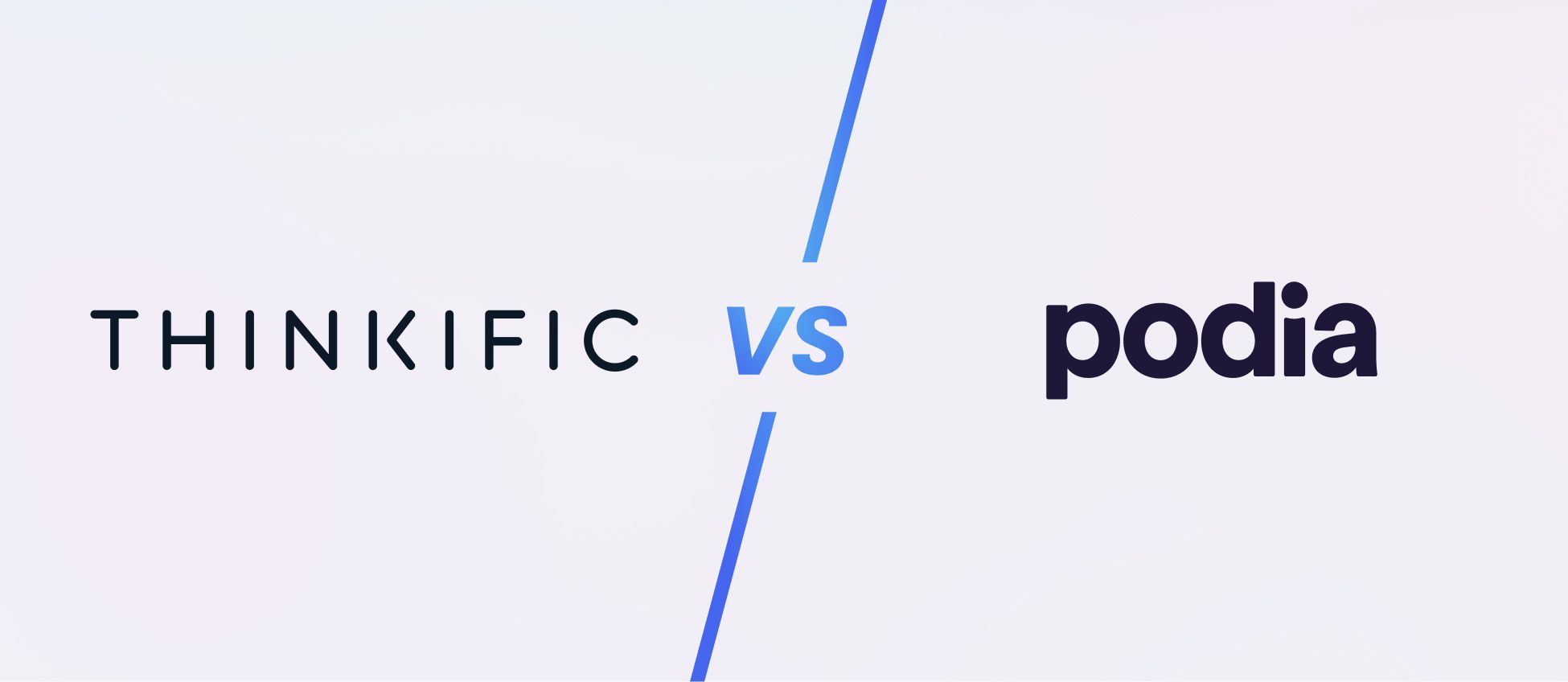
Introduction
Most comparisons between Podia and Thinkific stop at a superficial feature list. This analysis goes deeper, built on years of hands-on experience helping creators migrate from these platforms.
As the Esmerise team, we didn’t just *use* Podia and Thinkific: we thoroughly documented transitions, pain points, and success factors for hundreds of creators who left them behind. That gives us a unique and grounded perspective on how they actually perform.
We know exactly where each platform shines, where it creates friction, and which specific creator needs each one is, or isn’t, designed for. We’ll conduct a pragmatic evaluation of Podia and Thinkific, focusing on what truly matters for creators. Then, we’ll introduce Esmerise, the platform we engineered as a direct response to the gaps and opportunities we discovered along the way.
The goal is to give you the clarity you need to make a critical strategic decision. Your platform shapes your operational efficiency, your students’ experience, and your business success.
As the Esmerise team, we didn’t just *use* Podia and Thinkific: we thoroughly documented transitions, pain points, and success factors for hundreds of creators who left them behind. That gives us a unique and grounded perspective on how they actually perform.
We know exactly where each platform shines, where it creates friction, and which specific creator needs each one is, or isn’t, designed for. We’ll conduct a pragmatic evaluation of Podia and Thinkific, focusing on what truly matters for creators. Then, we’ll introduce Esmerise, the platform we engineered as a direct response to the gaps and opportunities we discovered along the way.
The goal is to give you the clarity you need to make a critical strategic decision. Your platform shapes your operational efficiency, your students’ experience, and your business success.
How easy are Podia, Thinkific, and Esmerise to use?
How truly intuitive are these platforms in daily work? Beyond the marketing claims, here we examine the actual user interface and operational efficiency of Podia, Thinkific, and Esmerise.
| Feature | Thinkific | Podia | Esmerise |
|---|---|---|---|
| Initial accessibility | ⭐️⭐️⭐️⭐️ | ⭐️⭐️⭐️⭐️⭐️ | ⭐️⭐️⭐️⭐️⭐️ |
| Day-to-day operational speed | ⭐️⭐️⭐️⭐️ | ⭐️⭐️⭐️⭐️ | ⭐️⭐️⭐️⭐️⭐️ |
| Learning resources | Text-based, English only | Video/text, English only | Video guide, 4 languages |
| Mobile management | Via mobile browser | Via mobile browser | Full functionality |
Thinkific
📌 Want a broader view? See our complete guide to the best Thinkific alternatives.
Interface
Thinkific gets off to a good start: the interface is generally intuitive, especially for beginners. However, diving deeper, you notice that the attention to design doesn't quite seem at Podia's level: sometimes the menus can feel a bit numerous, and the dimensions of certain elements don't always appear pixel-perfectly optimized. That said, it's nothing that blocks you: the main functions remain accessible. And one data point speaks volumes: the creators we've helped migrate from Thinkific rarely cited basic usability as their main reason for leaving – a sign that, despite some room for aesthetic improvement, the platform gets the job done.Resources and Language
A crucial factor, especially outside the Anglosphere: Thinkific operates exclusively in English 🇬🇧. This applies to the user interface, the extensive help center (rich with text articles), and all official support channels. Although many unofficial guides exist online in other languages, it's vital to check their date, as they might refer to past versions of the platform.Mobile Management
What about managing on the go? 🤳 The experience for creators on Thinkific via mobile browser is decent but inconsistent. Some areas are well-optimized for smartphones, but for more complex operations or accessing all features, desktop use often remains necessary. This represents a non-negligible limitation for those who frequently work remotely, although it must be said that complete mobile management for the creator is still a rarity in the sector (with Esmerise being the notable exception).Podia
📌 Want a broader view? See our complete guide to the best Podia alternatives.
User Interface
Podia's interface is well-proportioned and, in our opinion, visually a bit cleaner and more modern than Thinkific's, even though the basic functionalities are often substantially comparable. The user experience on Podia is therefore more direct, allowing for quicker familiarization with the main tools 🚀.Resources and Help Language
Podia's admin area and its documentation are only in English 🇬🇧. A positive aspect to highlight is that when accessing new sections or features of the platform, you often find short and useful contextual video guides 🎬.Mobile Management (for Creators)
Podia does not have a native mobile app dedicated to creators for managing their business, which is undoubtedly a drawback for those who need to operate frequently on the go. However, it must be said that, as we've already seen in other comparisons, almost no platform on the market, apart from Esmerise, offers a truly complete creator application. Podia's responsive web interface does, however, allow for controls and edits from a smartphone 📱.Esmerise
Interface
Launched in 2021, Esmerise leverages newer technologies for a radically different user experience. The main innovation? No separation between backend and frontend. The view is unified and consistent for both creator and student, eliminating the need to switch between "build" and "preview" modes. ✨ The result is an extremely fluid, intuitive, and contextual workflow that reduces steps and makes the platform immediately understandable.Resources
We chose a targeted learning approach: instead of scattered text documentation, we offer a complete video guide. It's broken into short chapters for quick, visual learning, guiding you step-by-step. Available in Italian, English, Spanish, and French 🇮🇹🇬🇧🇪🇸🇫🇷.Mobile Management
Designed mobile-first from day one, the Esmerise interface ensures a flawless smartphone experience (as seen in the screenshot), both via browser and the dedicated app 📱. As a creator, you can manage every single feature without limitations directly from the app: a first in this industry. ✅How do Podia, Thinkific, and Esmerise handle course creation and student experience?
Let's get to the core offering: how are courses built and, crucially, experienced by your students on these platforms? 🧑🎓
In terms of basic features for structuring content (lessons with text, video, attachments, quizzes, progressive release or drip), Podia and Thinkific offer very similar toolsets. Unless you have specific needs, the differences here are minor and not decisive for your choice.
The real game-changer, however, lies elsewhere: the student-facing learning experience. This is where fundamental divergences emerge, directly impacting engagement, completion rates, and learning success.
In terms of basic features for structuring content (lessons with text, video, attachments, quizzes, progressive release or drip), Podia and Thinkific offer very similar toolsets. Unless you have specific needs, the differences here are minor and not decisive for your choice.
The real game-changer, however, lies elsewhere: the student-facing learning experience. This is where fundamental divergences emerge, directly impacting engagement, completion rates, and learning success.
Thinkific
Course Creation
Thinkific's course editor is functional, though it doesn't exactly shine with innovation. It adopts a classic layout: on the left, you have the course structure (modules and lessons), and on the right, you edit the individual lesson. This approach, while familiar, can make the interface feel rather full and sometimes a bit confusing, especially with complex courses. Adding content via drag-and-drop is reasonably intuitive, but the customization options for elements like quizzes or drip content remain somewhat basic. In essence: it gets the job done for creating standard courses, but without particular flair or refinement in the editing experience.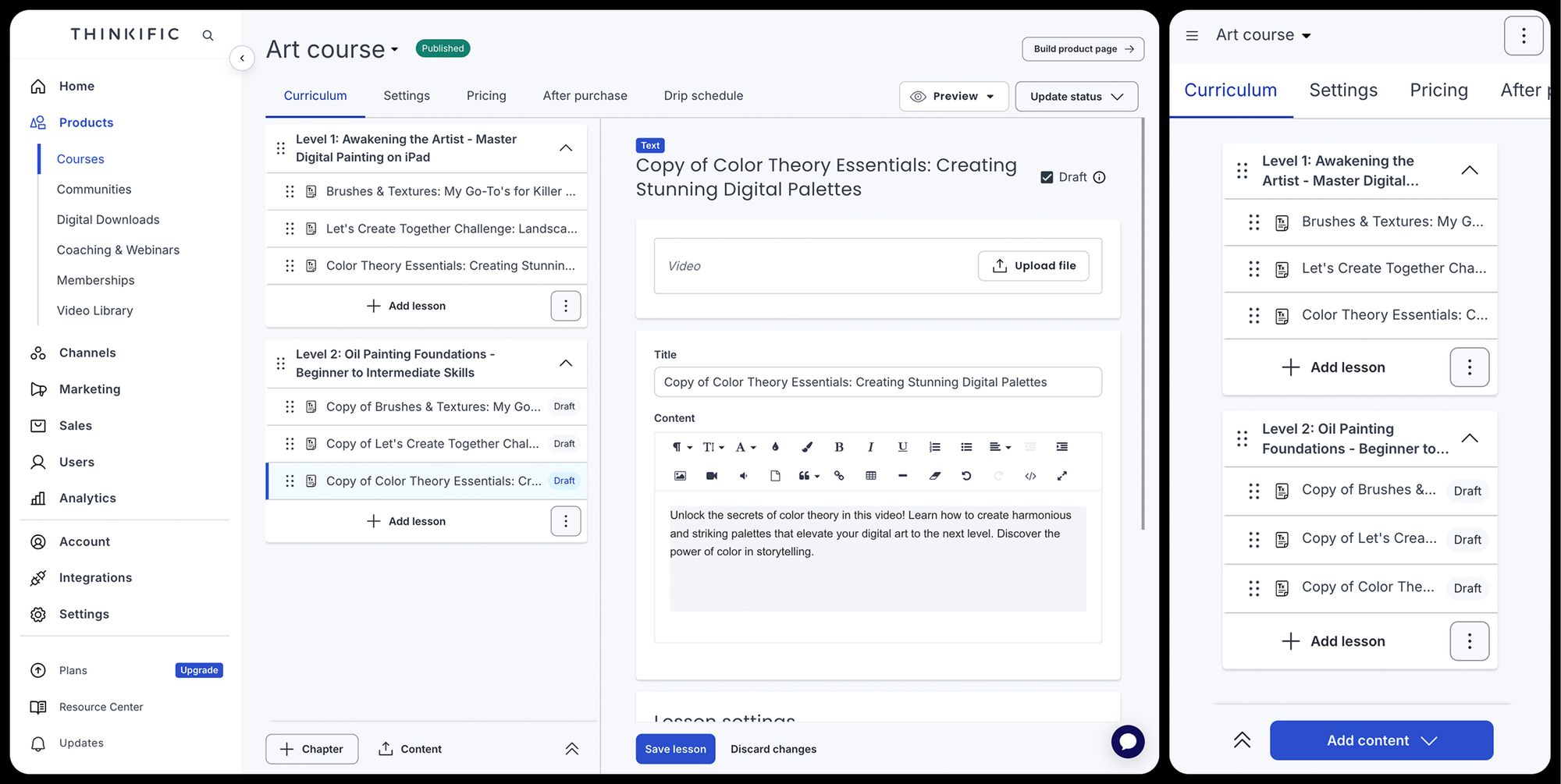
User Experience (Student)
On the student side too, Thinkific offers the classic setup with a content list on the left and the lesson player opening in the main area. It's a traditional approach that, honestly, is starting to feel rather 'outdated' and visually unappealing ('a bit plain/ugly'), especially when compared to Podia's more polished aesthetics or, even more so, Esmerise's integrated experience. While viewing the lesson, there's no sign of integrated community or gamification; the experience is solely focused on the video or text content, making it functional but potentially isolating and unstimulating compared to more modern and engaging models. 🧊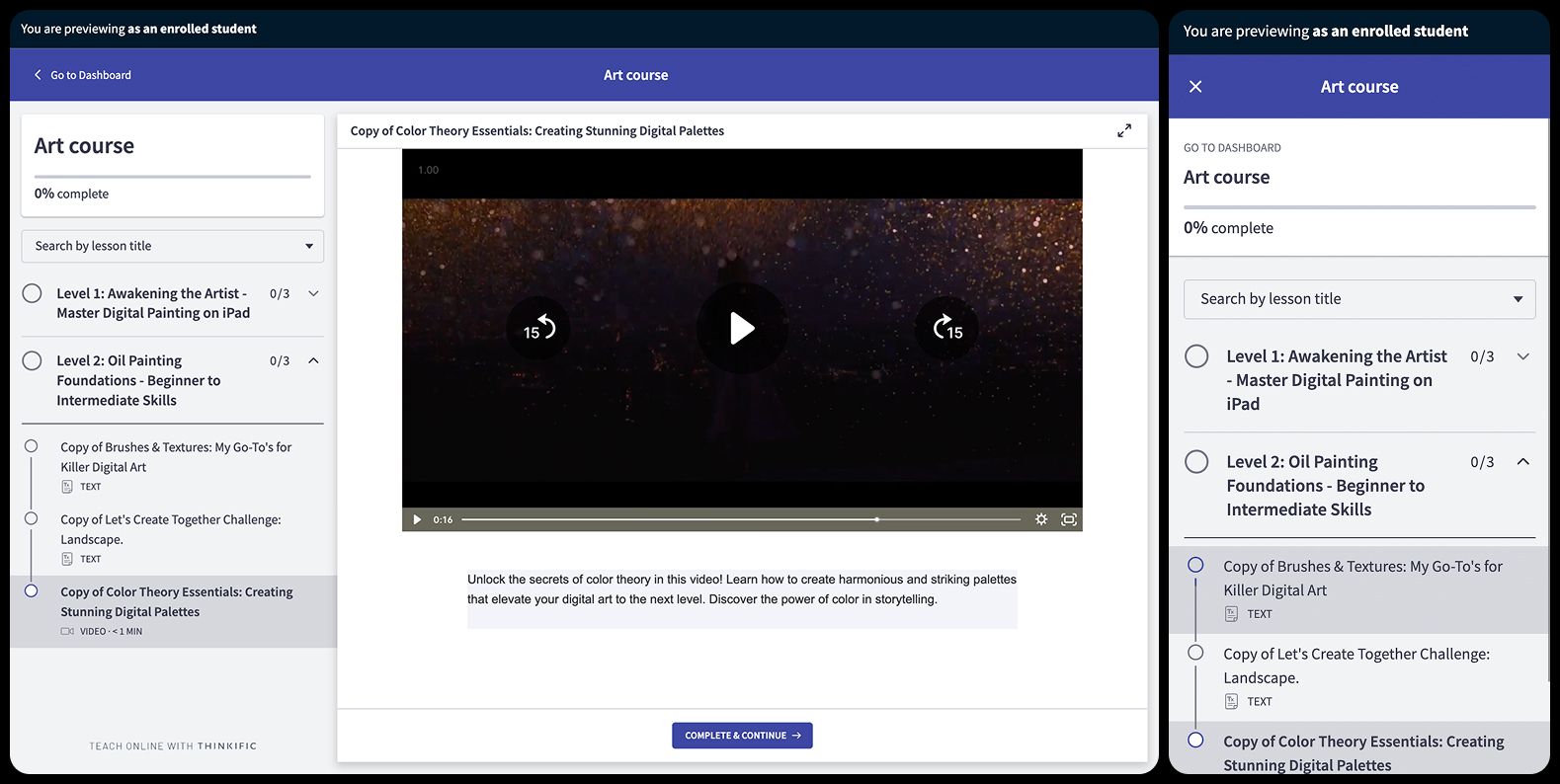
Podia
Course Creation
Podia's course builder offers a clean and functional interface, somewhat reminiscent of Kajabi's: neither particularly innovative nor openly frustrating. Buttons are well-positioned, and adding content is intuitive.
Student User Experience
For course consumption, Podia adopts the classic "list of contents" layout. A standard e-learning approach that, however, is beginning to feel dated and not very engaging for the modern student.Although Podia includes good community features, these operate rather separately from the course area. Integration amounts to a discreet 'Discussions' button in the course interface, useful for occasional questions, but insufficient to truly merge learning with dynamic social interaction.
On the mobile front, students access content exclusively via browser, as Podia does not offer a dedicated app.
Overall, this "old-fashioned" vision of course consumption, while ensuring basic functionality, struggles to compete with the more integrated and stimulating user experiences available today. That said, it must be acknowledged that Podia's user interface for viewing courses is, in itself, extremely clean, tidy, and well-designed.

Esmerise
Course Creation
Esmerise includes essential learning tools (text, video, quizzes, drip) but radically modifies the workflow. Creation happens directly within the academy 🪄, in the same environment as the student, eliminating the backend/frontend separation. You build seeing exactly what they'll see. The result is a noticeably faster, more intuitive, and coherent process.
User Experience (Student)
Here the difference is substantial: courses aren't isolated modules, but part of an integrated learning ecosystem. A synergy is created between content, community, and gamification, transforming the classic lesson list into a living, participatory digital academy 🎓.This integration yields measurable results: our internal data shows completion rates up to 3x higher 📈 compared to traditional list-based platforms. As we'll explore in the Gamification & Community section, it's precisely these social and engagement dynamics that transform the student's experience and motivation.

What sales and marketing tools do Podia, Thinkific, and Esmerise offer?
While in course creation, Podia and Thinkific have nuanced differences, it's on the sales and marketing 💰 front that clear strategic divergences emerge, crucial for your business.
Let's now examine the fundamental tools to monetize and grow your activity: from product and payment management, to building an effective site and sales pages, through to the essential integrations with the external marketing ecosystem.
Let's now examine the fundamental tools to monetize and grow your activity: from product and payment management, to building an effective site and sales pages, through to the essential integrations with the external marketing ecosystem.
Thinkific
Product and Payment Management
Thinkific allows you to sell courses, communities, memberships, bundles, and coaching. Regarding payments, Thinkific offers two options:- Thinkific Payments (built-in): Available in many countries, it's still "powered by" Stripe but more integrated into the platform. For example, you can manage refunds and transactions directly from Thinkific without needing to log into Stripe.
- Direct Gateways (Stripe/PayPal): Alternatively (or in addition, regarding PayPal), you can connect your Stripe or PayPal accounts to receive payments more independently and with direct access to funds.
Sales Pages & Website
Thinkific includes a site builder with customizable themes, useful for quickly creating a storefront site and sales pages. The templates are decent and allow for a fast setup. However, based on both direct experience and discussions with various creators who moved to Esmerise, the site editor is not a strong point.The interface feels confusing and unintuitive, and customization is limited to working "around" the predefined templates. This makes it decidedly less flexible than the more advanced editors offered by Podia and Esmerise.
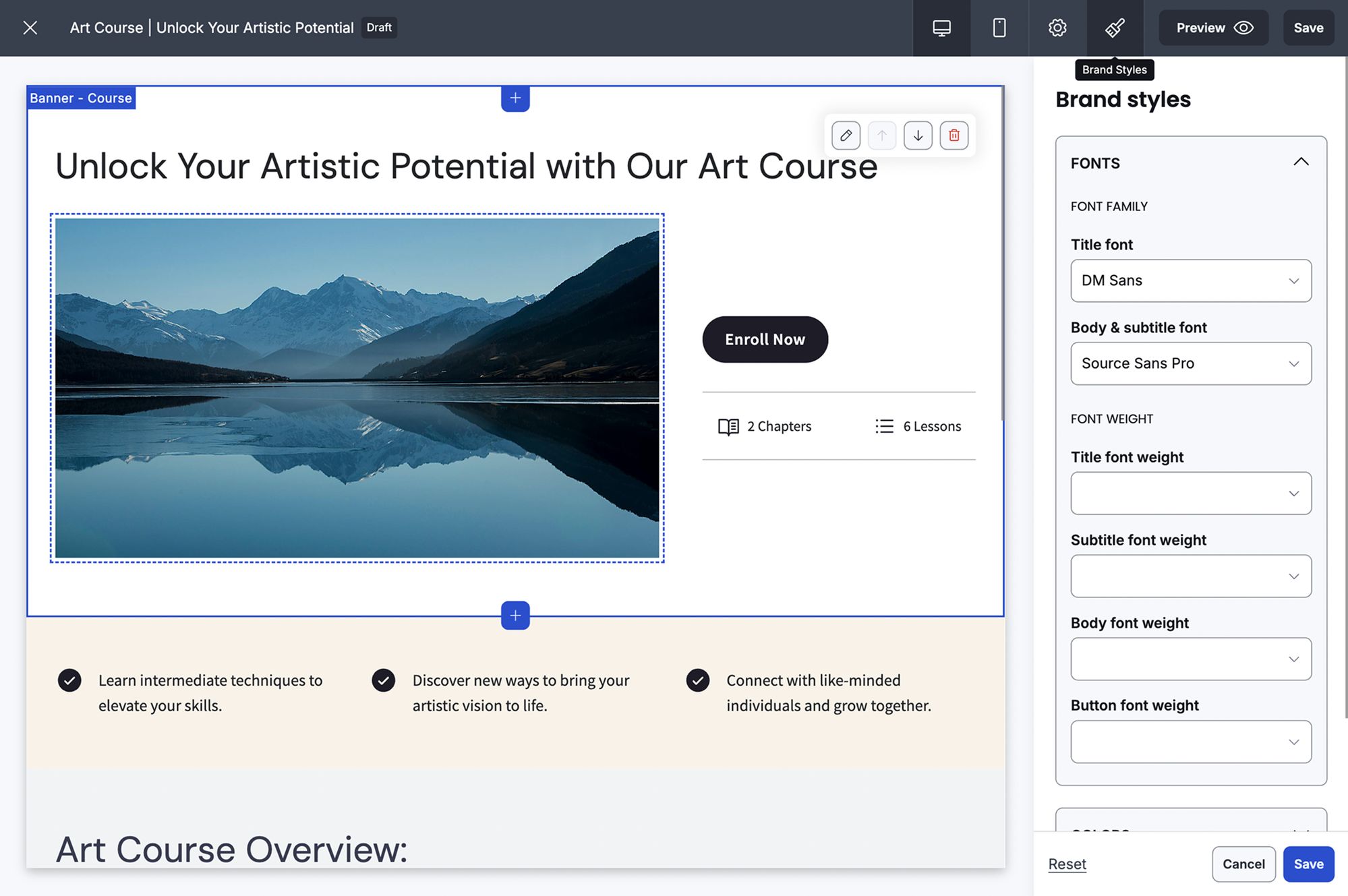
External Integrations
Thinkific has an excellent integration store called the Thinkific App Store 🛒, which offers direct connections with many popular services (email marketing like Mailchimp, ConvertKit, ActiveCampaign; analytics; CRM, etc.), and functionality extensions. For everything else, there's a solid integration with Zapier.In general, Thinkific has an open and flexible approach comparable to Podia, with direct connections to many services but also the ability to use Zapier for everything else.
Podia
Product and Payment Management
With Podia you can easily sell:- Complete online courses
- Digital downloads (ebook, template, audio file)
- Coaching sessions
- Webinars (by integrating external tools like Zoom or YouTube Live, then managing access and sales via Podia)
- Bundles of different products
- Access to dedicated Communities
Payment management relies on solid integrations with Stripe and PayPal, also offering the ability to set up installment payment plans for your customers.
Sales Pages and Website
Podia particularly impressed us with its features dedicated to site and sales page building. Its page builder ranks among the best we have tested, on par with Esmerise's, revealing a clear and strong strategic investment by the platform in this area.Unlike other platforms like Thinkific, where site creation can seem almost like an ancillary feature, for Podia it represents a strong point, on which the company also invests in terms of communication and marketing.

External Integrations
Regarding external integrations, Podia offers a good starting set. It provides direct integrations with several well-known email marketing software, plus native connections with Discord for communities and with Zoom for webinars and coaching 💻.One aspect we found useful in Podia is its integrated email marketing system. For many creators, this internal solution can be more than sufficient for managing newsletters and simple automations, without the immediate need to add a dedicated service.
For more specific integration needs or to connect with tools not natively covered (like certain CRMs or advanced analytics tools), Podia relies on Zapier, as is common practice for many platforms.
In summary, Podia's integration management seemed practical and well-conceived overall to us, entirely comparable to Thinkific's.
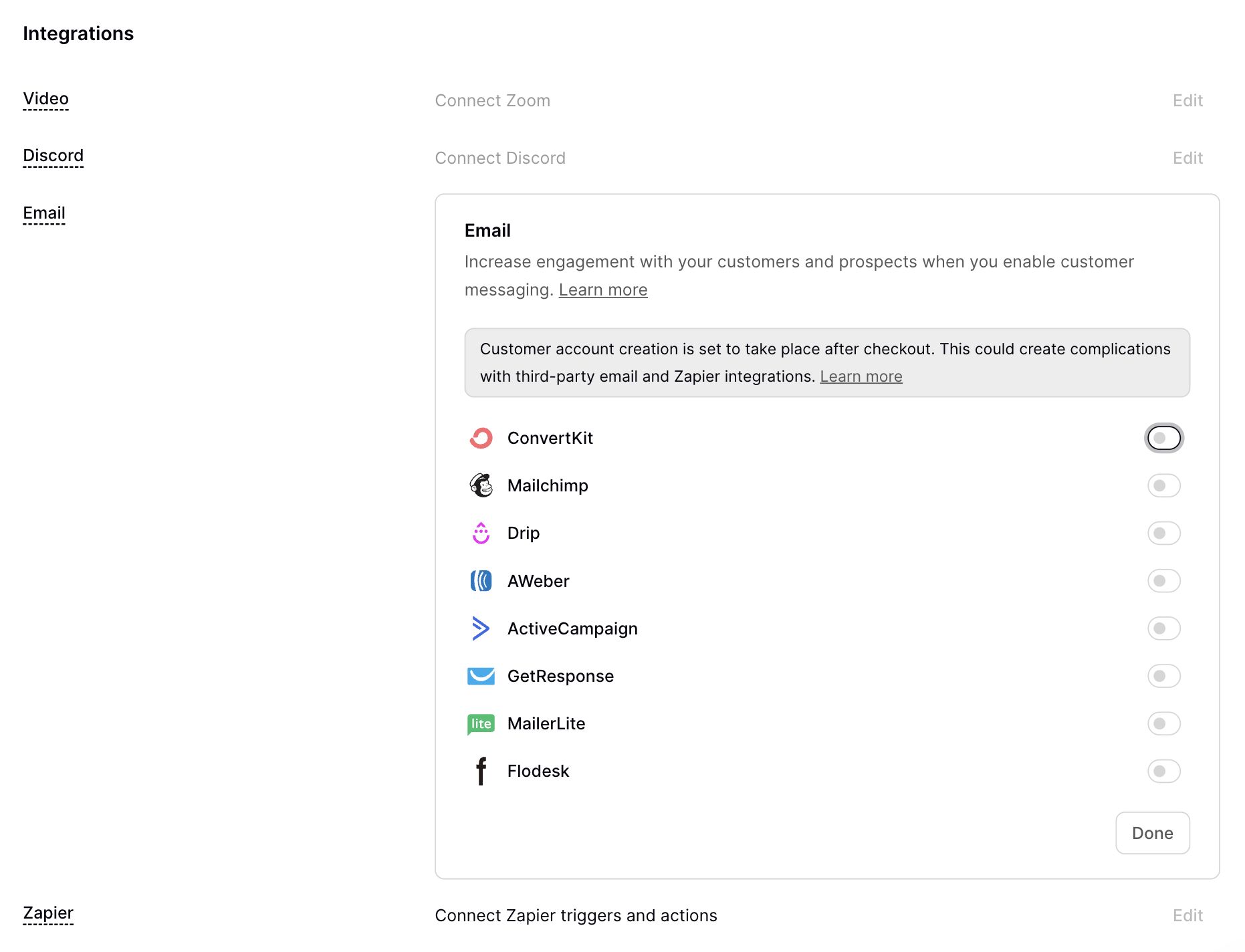
Esmerise
Product and Payment Management
Here Esmerise takes a noticeably simpler and more centralized approach compared to the "siloed" logic (separate products for courses, community, etc.) of Podia and Thinkific. Everything starts from a single product definition 💡.You decide the access type (one-time, subscription, installments, or free) and then simply associate:
- the learning content (modules, lessons)
- community permissions (which areas)
- any gamification bonuses.
This unified architecture shows its advantages especially with subscriptions, overcoming limitations seen elsewhere. With Esmerise you can easily:
- Create memberships that combine access to content + community + gamification in one plan.
- Allow a user to have multiple active subscriptions simultaneously (e.g., basic course + advanced coaching).
- Manage automatic upgrades between tiered plans (e.g., Standard to Premium), with proration and deactivation handled by the platform.
For payments, we offer maximum flexibility supporting Stripe and PayPal in parallel 💳, installment payments (with 3 provider options), and recurring subscriptions. All manageable in multiple currencies within the same academy, with the option to activate an optional module for automated electronic invoicing (tax calculation included) 🧾.
Sales Pages and Website
Our page builder is designed to combine power and intuitiveness. It allows you to create visually appealing, high-converting sales pages with no code needed, featuring seamless native integration with the checkout system.
External Integrations
Unlike the limited or intermediary-based approaches seen elsewhere, Esmerise focuses on direct native connections with your marketing ecosystem. The list is constantly growing and already includes essential tools like: ActiveCampaign, Aweber, Brevo, ConvertKit, Facebook Pixel, Flodesk, GetResponse, Google Analytics 4, Google Tag Manager, HighLevel, Klaviyo, MailerLite, MailChimp, PayPal, SmsHosting, Spoki, Systeme, TrustPilot, and more.The practical advantage? When a user purchases, their data flows automatically into your preferred CRM or email marketing software, with no need for Zapier or manual configurations. A cleaner, more reliable, and efficient workflow.
How do Podia, Thinkific, and Esmerise handle community and gamification?
| Feature | Thinkific | Podia | Esmerise |
|---|---|---|---|
| Gamification features | ❌ | ❌ | ✅ Yes, integrated in one space |
| Community features | 🟡 Yes, but separate from course area | 🟡 Yes, but separate from course area | ✅ Yes, integrated in one space |
| Branded App | 🟡 Yes, with additional cost | ❌ | ✅ Yes, included |
A strategic aspect often overlooked by creators is this: designing learning paths that keep students engaged all the way to completion. 🎯
The connection is direct: higher completion rates mean more satisfied students, tangible results, positive word-of-mouth, and thus, greater sustainability for your business.
Conversely, a course with extremely low completion is, effectively, an ineffective product. Unfortunately, industry statistics are alarming: estimates suggest average rates between just 5% and 15% 📉. A huge problem.
However, there are proven levers to reverse this trend: the strategic integration of community 🤝 and gamification 🎮.
It is precisely on these elements, crucial for learning effectiveness, however, that neither Thinkific nor Podia manage to offer truly integrated and satisfactory solutions.
The connection is direct: higher completion rates mean more satisfied students, tangible results, positive word-of-mouth, and thus, greater sustainability for your business.
Conversely, a course with extremely low completion is, effectively, an ineffective product. Unfortunately, industry statistics are alarming: estimates suggest average rates between just 5% and 15% 📉. A huge problem.
However, there are proven levers to reverse this trend: the strategic integration of community 🤝 and gamification 🎮.
- Community recreates the social dynamic essential for learning: a place to interact, ask, share, and feel part of a group, drastically reducing dropout risk.
- Gamification (points, badges, levels, leaderboards) transforms learning into a more interactive and motivating experience, encouraging consistent progress.
It is precisely on these elements, crucial for learning effectiveness, however, that neither Thinkific nor Podia manage to offer truly integrated and satisfactory solutions.
Thinkific
Thinkific includes a community feature, but it's designed as a distinctly separate section from the courses. Students can interact there, but this lack of integration creates a fragmented experience 🧩: to discuss, they must leave the lesson context, disrupting the learning flow and reducing opportunities for contextual interaction.On the gamification side, the situation is even clearer: Thinkific offers no native features 🎮❌. To introduce elements like points or badges, resorting to external tools (e.g., Pointagram) is mandatory, which involves manual setups, potential extra costs, and a potentially less cohesive user experience.
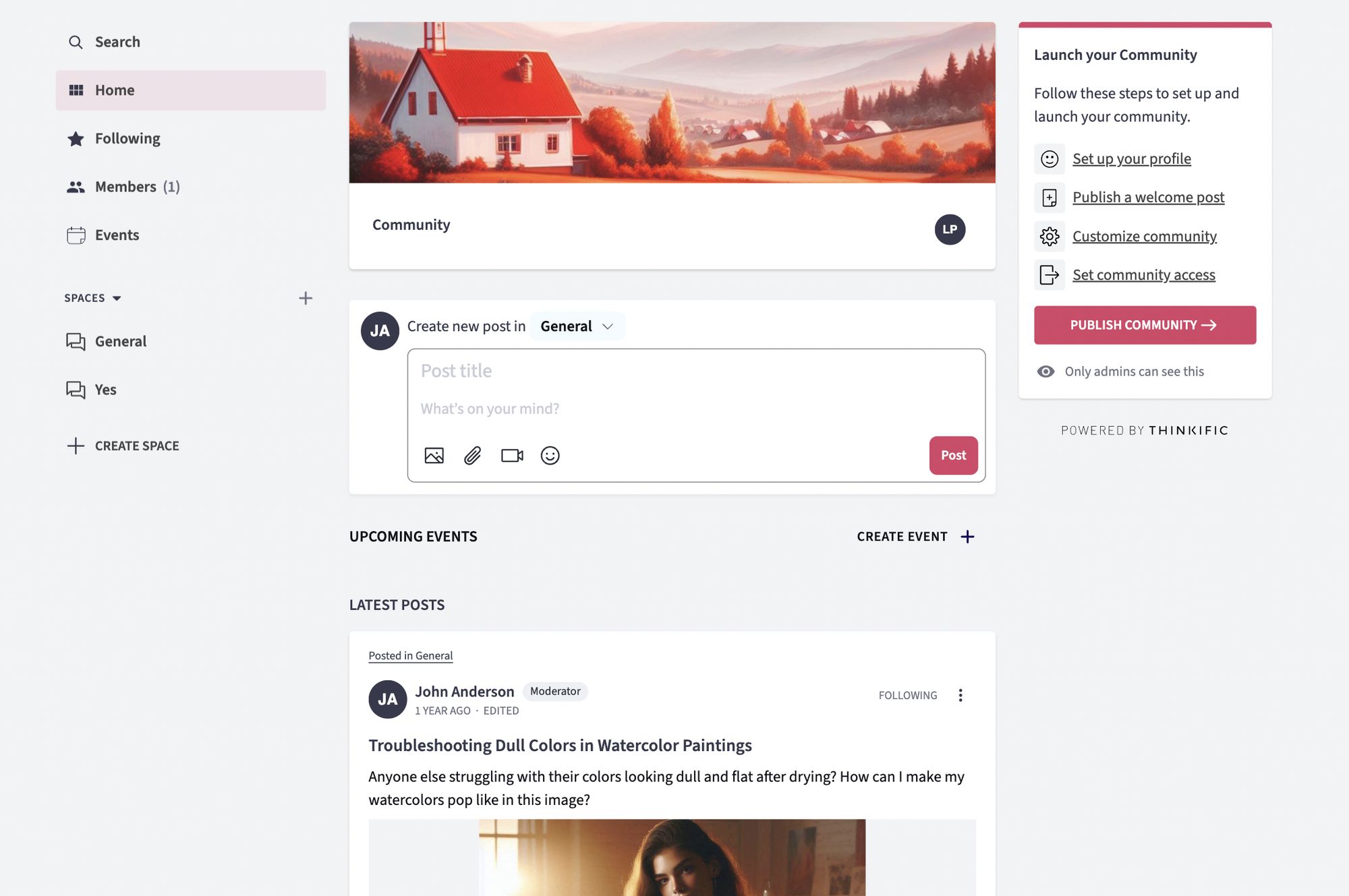
Podia
Podia includes sound community features. These are conceived more as separate products to sell (or offer for free) rather than as a function deeply integrated into learning paths; an approach that we find similar to that of Thinkific. We were impressed by the ability to create both public (free) and private communities, offering considerable flexibility.On the gamification side, unfortunately Podia doesn’t offer any dedicated feature to increase student engagement.
As mentioned previously, the lack of elements like advanced gamification, and a community primarily designed as a standalone product, contribute to a learning experience that, while functional, can feel a bit dated. It should be said that a similar consideration, for these specific aspects, also applies to Thinkific.

Esmerise
Unlike the separate features of Podia and Thinkific, Esmerise natively fuses community and gamification into the learning experience 🤝🎮. It does this through modular tools you activate and combine as needed.You can integrate a forum for structured discussions or a group chat for immediate interaction, all accessible directly within the learning environment, creating a cohesive space that fosters connection and active participation.
Gamification is also integrated and flexible: assign points or rewards for progress, consistency, or community interaction. You can build a real internal economy 🏆 with badges and rewards to boost engagement and motivation.
This integrated approach isn't arbitrary; it's backed by learning science research 🧠 (like studies published in academic journals such as BJET or Computers in Human Behavior) showing that the synergy between social interaction and game mechanics significantly accelerates learning and motivation.
For Esmerise, community and gamification aren't add-ons; they are foundational elements. We design academies as living digital environments ✨, crafted to deliver a superior learning experience for both your students and you.
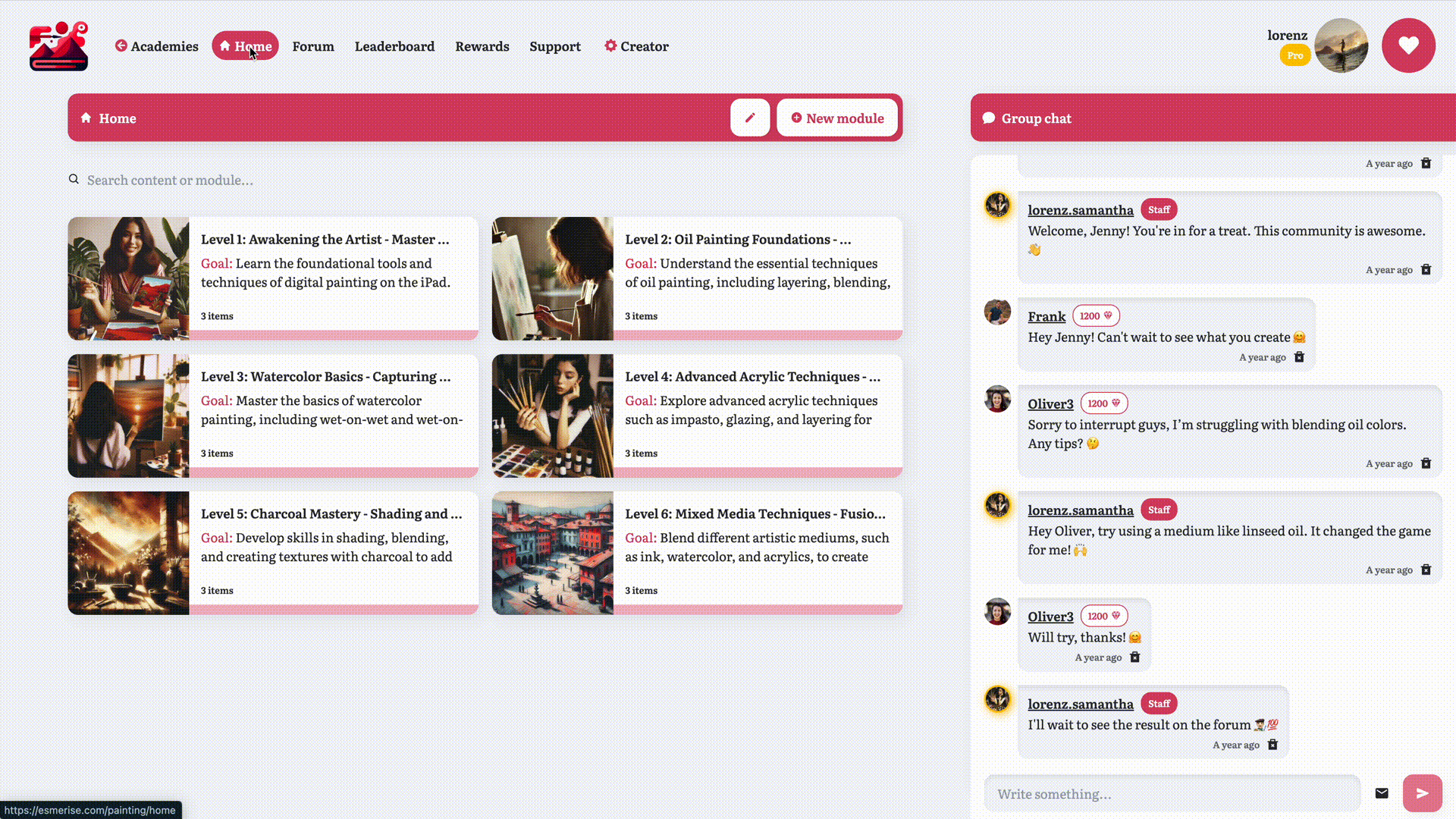
What is the mobile experience and branded app offering like on Podia, Thinkific, and Esmerise?
| Feature | Thinkific | Podia | Esmerise |
|---|---|---|---|
| Creator app | ❌ | ❌ | ✅ Yes, no feature limitations |
| Student app | 🟡 Very low reviews on iOS | ❌ | ✅ Available |
| Community inside the app | ✅ Integrated in main app | ❌ | ✅ Integrated in main app |
| Branded app | 🟡 Yes, with extra subscription | ❌ | ✅ Included, no extra cost |
Learning (and managing online businesses) is increasingly mobile 📱. Market forecasts (e.g., Mordor Intelligence) indicate explosive growth for m-learning (+20% annually).
This means not only do your students expect to consume content conveniently via smartphone, but you, as a creator, also need the flexibility to manage your business from anywhere.
In this context, offering a native app customized with your brand (white-label) ceases to be a luxury and becomes a strategic advantage ✨: it strengthens brand identity, ensures a superior user experience, and makes accessing your content immediate.
This means not only do your students expect to consume content conveniently via smartphone, but you, as a creator, also need the flexibility to manage your business from anywhere.
In this context, offering a native app customized with your brand (white-label) ceases to be a luxury and becomes a strategic advantage ✨: it strengthens brand identity, ensures a superior user experience, and makes accessing your content immediate.
Thinkific
Let's start with a clear point: Thinkific does not provide a native app for creators ❌. Business management happens via the mobile browser, an experience that's functional for basics but limited, often forcing a return to the desktop for complete operations.For students, there's an official app (iOS/Android), but beware:
- The reviews on iOS are particularly critical 📉. Users complain about frequent crashes, videos freezing, and a generally subpar user experience.
- The standard app is not white-label: it displays the Thinkific brand everywhere, diluting your own brand identity 🏷️.
Thinkific does offer the option of a custom white-label app for students, published under your name. However, this is a premium add-on 💸, tied to an extra subscription costing a hefty $199/month, to be paid on top of the platform plan, representing a significant and not very accessible investment.
In summary: the creator cannot manage anything from a dedicated app. For students, the branded app is a powerful solution but requires a considerable budget; otherwise, the free standard app suffers from issues (especially on iOS) and imposes Thinkific's branding.

Podia
On the mobile app front, Podia unfortunately lags behind ❌: it offers no dedicated application. This applies both to creators, who cannot manage courses from an app, and to students, who do not have an app to access content. It's not even available as a paid option.This is a significant shortcoming, especially considering that several competing platforms provide at least a student app, albeit often branded with the platform's own mark. That said, it must be acknowledged that Podia's mobile experience via browser is well-made and functional.
💡 Podia Mobile: no app for creators or students, not even with extra cost.

Esmerise
Esmerise takes a revolutionary approach: it’s the only platform on the market offering a single native app (PWA) for everything ✨. Easily installable from the browser, it includes all the features for creators and students, without limitations.As a creator, you can manage your entire business directly from your smartphone ✅ - you don't even need a computer. Students access courses, forums, chats, gamification, and notifications in a single, coherent and seamless environment, a clearly superior experience compared to the fragmented setup of Podia and Thinkific.
The Esmerise app also comes at no additional cost and is fully customizable with your brand (logo, colors, fonts), reinforcing your professional identity.
The feedback we constantly receive: the app is one of the most appreciated features ❤️. In an increasingly mobile-first world, Esmerise’s unified approach is a significant competitive advantage.
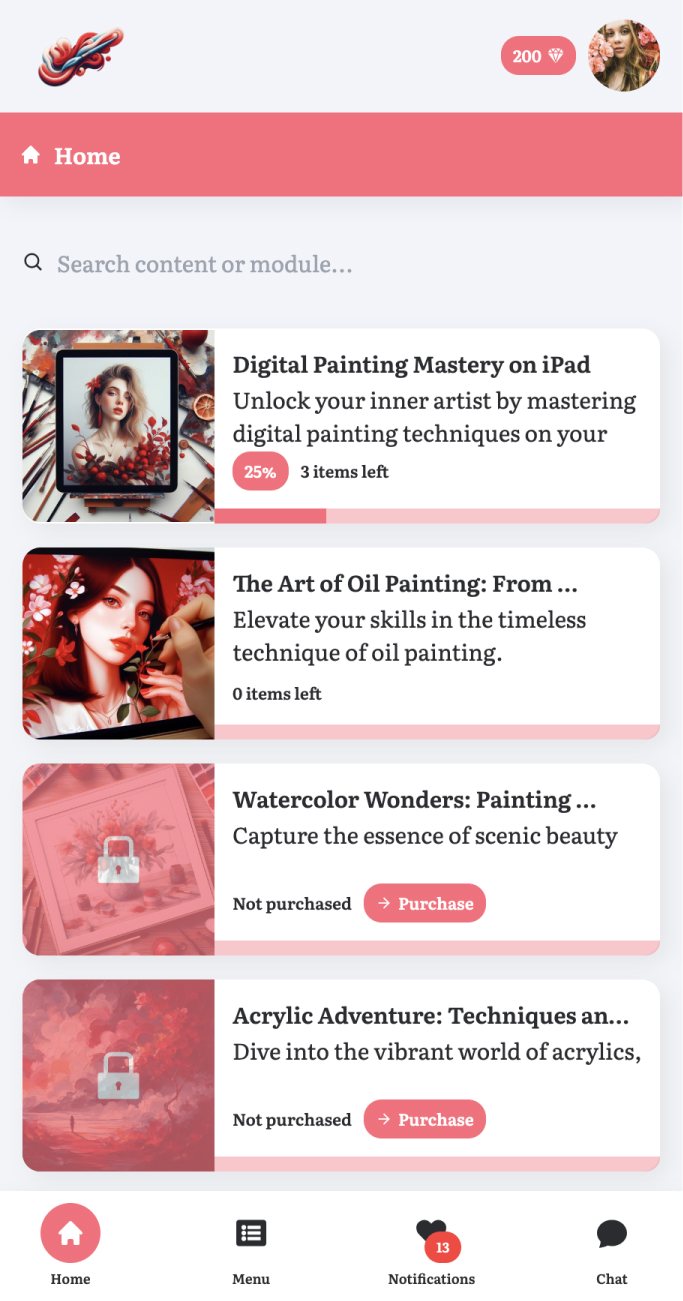
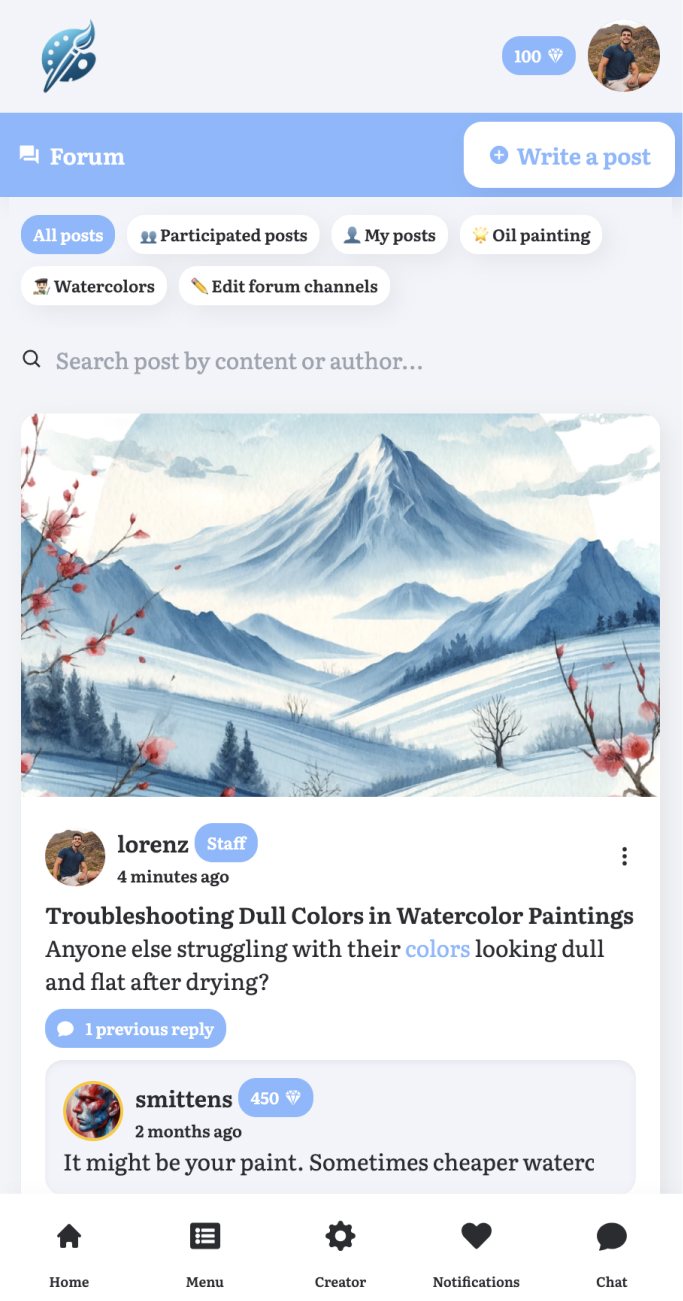
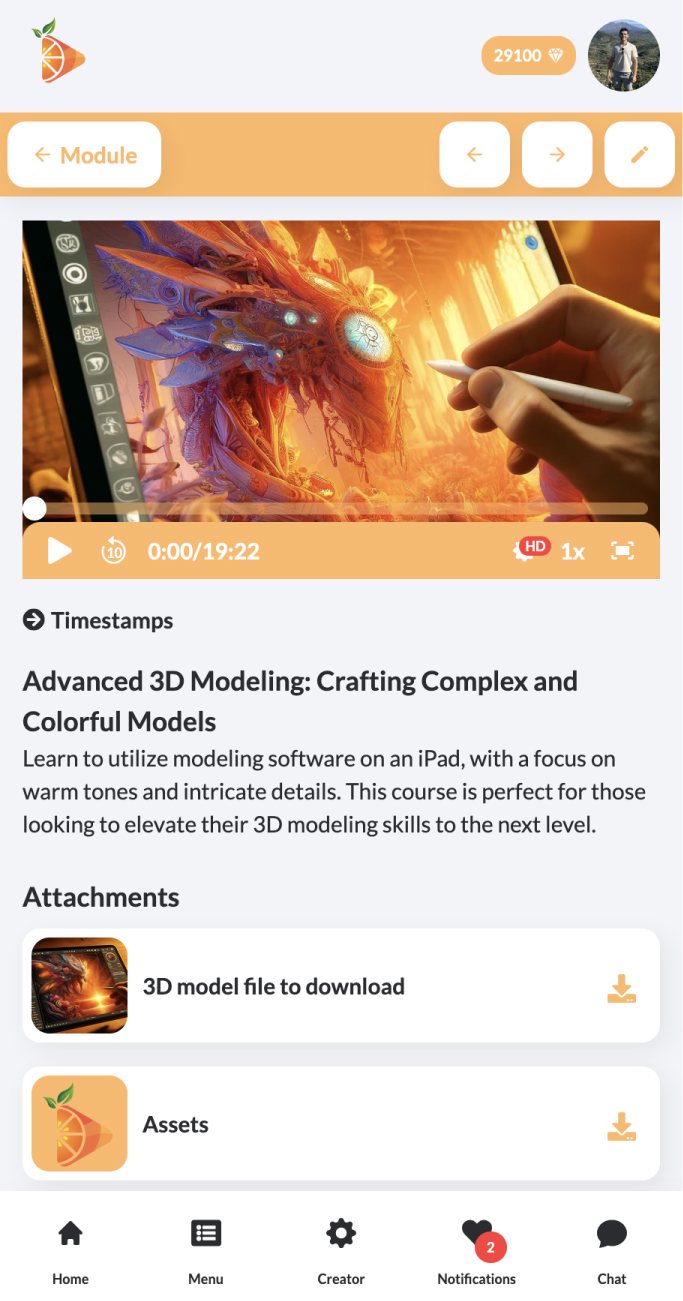
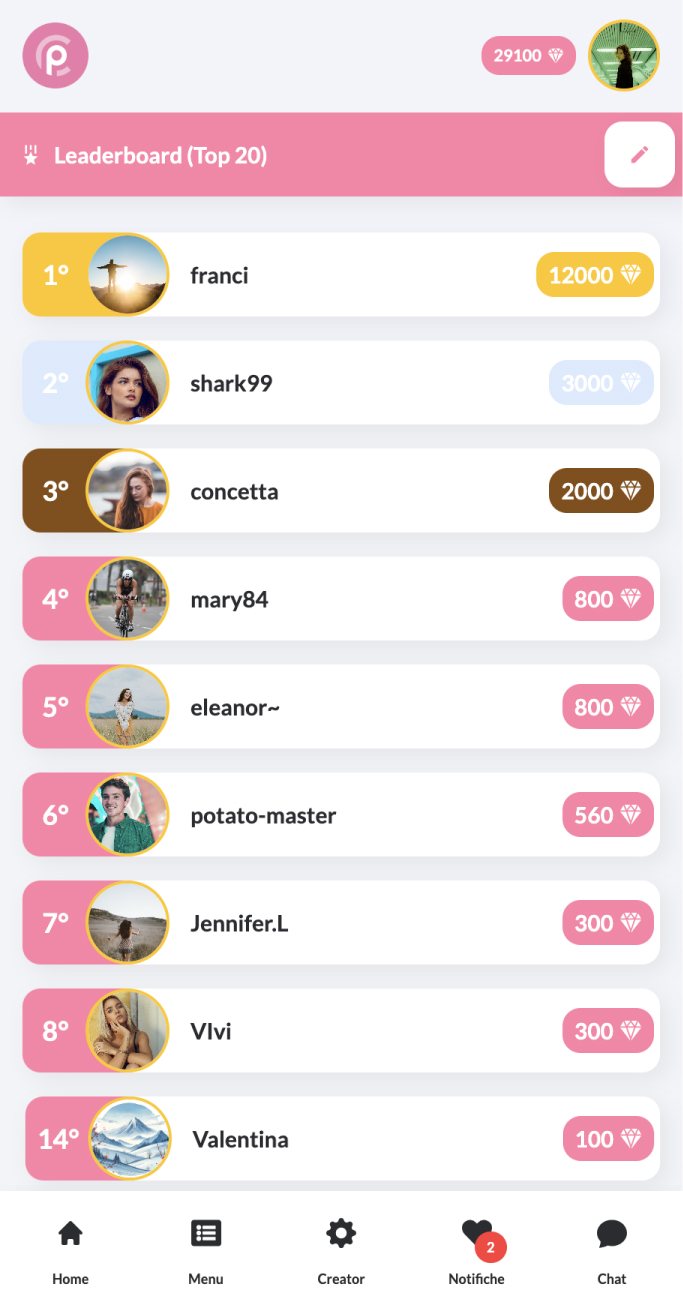

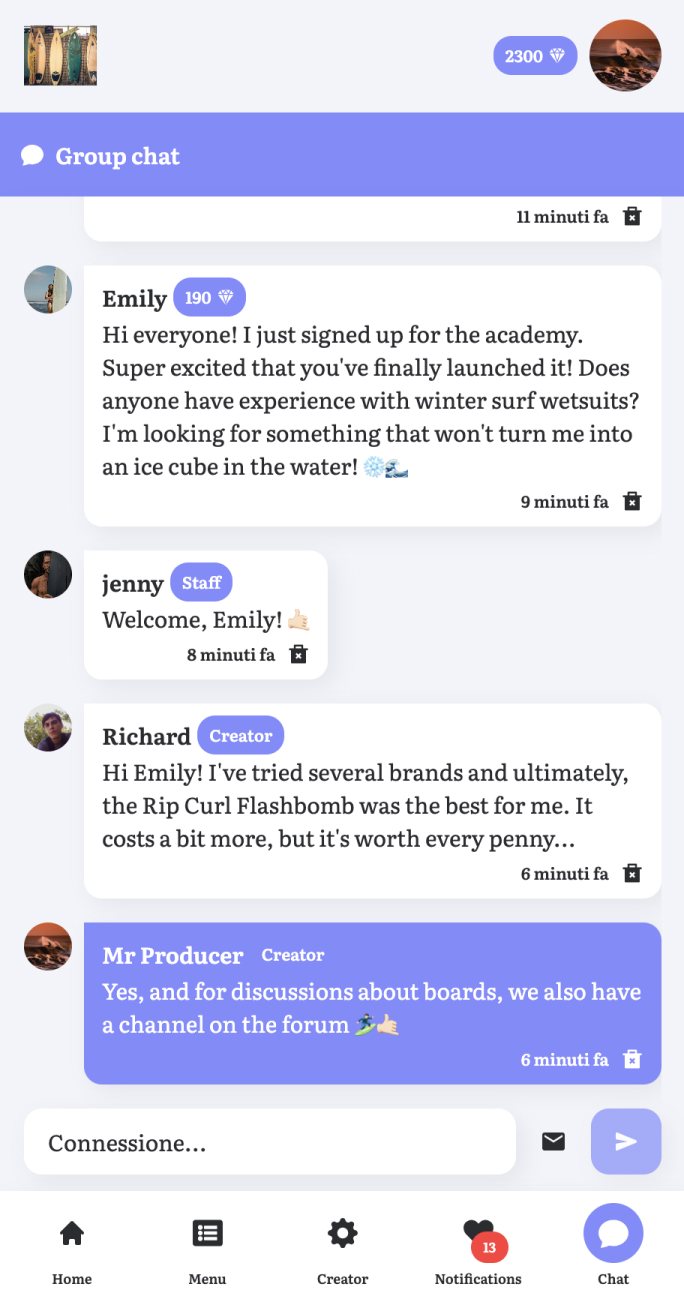






How much do Podia, Thinkific, and Esmerise cost?
Podia vs Thinkific: Pricing Strategies & Real Value
Podia presents itself with a simple and generally more economical plan structure. Its main paid plans offer unlimited products, with the key difference being that the entry-level plan (Mover) includes a 5% sales commission (which is still reasonable and can be eliminated by upgrading to the Shaker plan).Thinkific offers a basic plan ("Basic" at around $48/month) which, positively, applies no commissions and also includes unlimited courses. However, for features like subscriptions, it's necessary to upgrade to at least the "Start" plan (around $97/month). The real sore point, in our opinion, emerges with the need to remove Thinkific's branding: this requires the "Grow" plan, which costs a hefty $195/month! 💸
In summary:
- Thinkific may initially appear attractive, but it's crucial to evaluate potential additional costs. The outlay of $195/month just to remove the platform's logo is a significant hurdle. If you add the cost for a potential white-label app, as an add-on of $199/month, the price skyrockets considerably.
- Podia, on the other hand, focuses on competitive pricing and a simpler cost structure right from the start. Being perhaps a less "renowned" company than Thinkific, its strategy is based on an aggressive price-to-quality ratio that, we must admit, favorably impressed us.
In conclusion, Podia stands out for its transparency and immediate value, making it particularly interesting for those starting out or looking for a complete solution without hidden costs. Thinkific can still offer great value if its basic features are sufficient and there's no pressing need to remove branding or for a white-label app. Both, with their specific strengths, position themselves as valid alternatives to more expensive solutions like Kajabi.
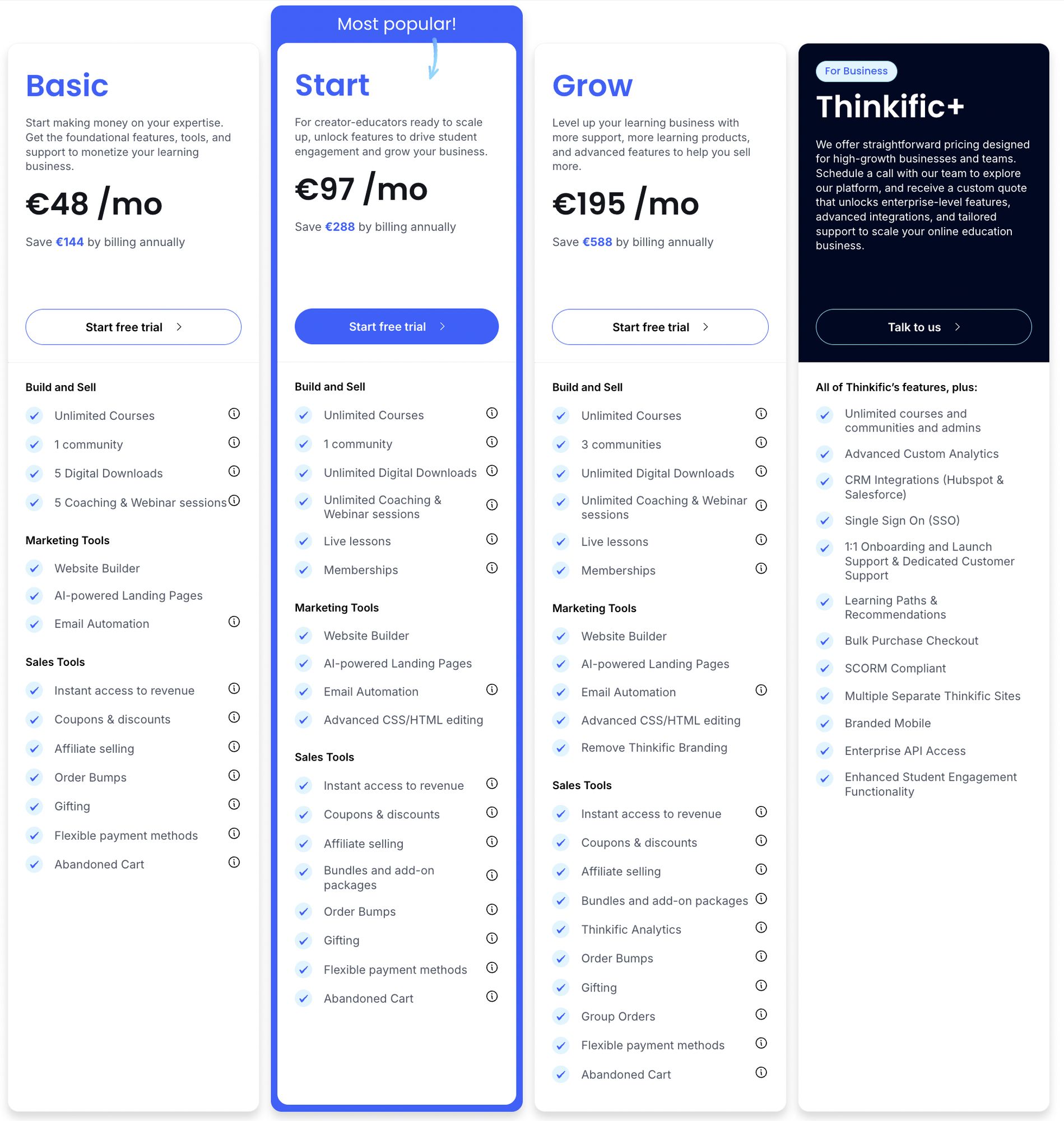

Esmerise's Positioning: Value and Accessibility
Our mission has always been radical: making the creation of extraordinary learning experiences accessible to everyone ✨. This is reflected in our plans:- The Basic Plan is designed for growth: it includes unlimited products ♾️ and many features that elsewhere require an upgrade, with no artificial limits for beginners.
- The Intermediate Plan offers exceptional value: it includes a fully brandable mobile app (with your icon and colors), a feature that comes at a high extra cost on Thinkific.
How can we offer more at competitive prices?
- Modern Technology 💡: Built later, we use a more efficient and scalable architecture, reducing infrastructure costs compared to older platforms.
- No "Brand Tax": Our price reflects the value of the product, not a hyped brand. A direct benefit for you.
- European Focus 🇪🇺: We understand the needs and often different budgets of European creators, and the platform is built with this in mind.
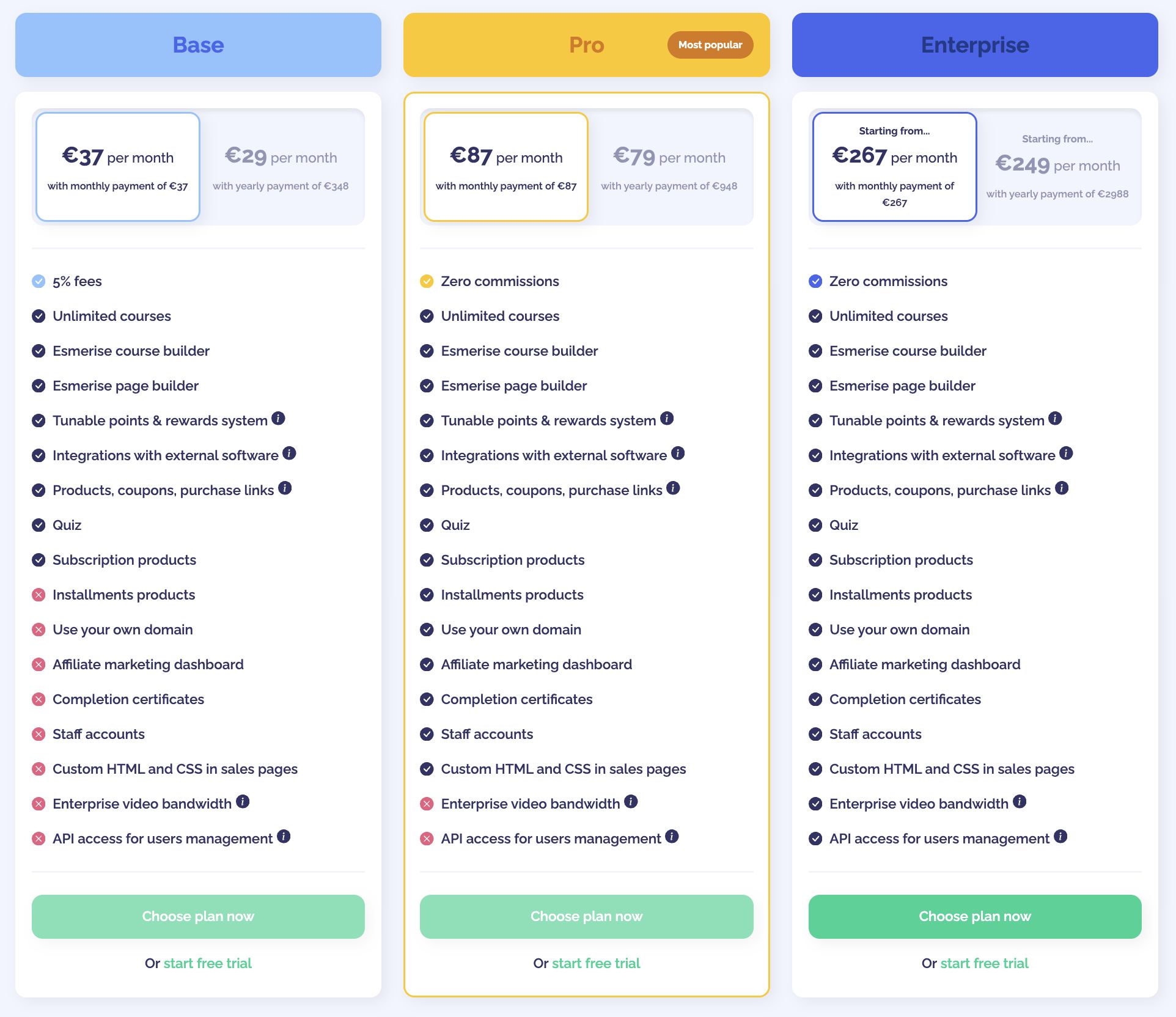
What kind of support and localization do Podia, Thinkific, and Esmerise offer?
Podia
An important factor outside the English-speaking world is language: Thinkific and Podia operate entirely in English 🇬🇧 (interface, resources, and support). If your students don't know English, consider that the lack of translations could complicate their daily use.Analyzing their support, Podia offers assistance via both chat and email. Creators who have switched to Esmerise from Podia have never expressed criticism of their customer service, and the platform's online reviews in this regard are generally very positive.
Thinkific also provides chat and email support on all plans, adding phone support for the $195/month plan. Similarly, creators coming from Thinkific generally describe the support received positively.
Esmerise, on the other hand, decisively focuses on international accessibility. Our platform, all guides, and technical support are available in 4 languages (🇮🇹🇬🇧🇪🇸🇫🇷). We offer support 7 days a week via email and WhatsApp, ensuring quick responses (usually within a few hours). And, a fundamental point for us: you will always speak with real people from our team, dedicated to helping you, without chatbots or automated responses. Human, multilingual, and truly responsive support that our customers greatly appreciate.
Final comparison: Podia vs Thinkific vs Esmerise
| Key aspect | Thinkific | Podia | Esmerise |
|---|---|---|---|
| Usability | ✅ Generally intuitive ⚠️ Design less polished than others 📱 Limited mobile mgmt (browser) | ✅ Intuitive and simple ✨ Clean & modern interface 📱 Limited mobile mgmt (browser) | ✅ Intuitive & fluid ✨ In-context interface 📱 Full mobile creator app |
| Language & resources | 🇬🇧 English Only 📚 Great text help center | 🇬🇧 English Only 🎬 Help center & mini video guides | 🇮🇹🇬🇧🇪🇸🇫🇷 4 Languages (UI & support) 🎬 Targeted video guides |
| Course (mgmt + student UX) | ⚙️ Traditional course editor 👴 Traditional student UX (list) 🧊 Course & community isolated | ⚙️ Traditional course editor 👴 Traditional student UX (list) 🧊 Community as separate product | 🪄 "In-context" course editor 🎓 Integrated student UX 🤝 Course + community + gamification |
| Marketing & sales | 📄 OK page builder (less flexible) ♾️ Unlimited courses (Base plan) 🔗 Thinkific App Store ❌ No built-in Email/Funnels | 📄 Great page builder & site mgmt 📧 Integrated email marketing ♾️ Unlimited products ⚠️ Fees on base plan | 📄 Intuitive & powerful page builder ✅ Flexible payments 🔗 Native integrations (all plans) ♾️ Unlimited products (all plans) |
| Community & gamification | 🟡 Community features but separate ❌ No native gamification | 🟡 Community features but separate ❌ No native gamification | ✅ Deeply integrated experience 🤝 Contextual forum/group chat 🏆 Advanced integrated gamification |
| Mobile & white-label app | ❌ No creator app (browser only) 📉 Poor iOS student app reviews 💸 White-label app: $199/mo extra | ❌ No native creator app ❌ No native student app 📱 OK mobile browser experience | ✅ 1 Unified app (creator+student) ✅ Full creator management app 🎁 White-label app included (Mid-Tier+) |
| Pricing & value | 💲 Accessible start ($48/mo) ♾️ Unlimited courses (Base) 💸 Branding removal: $195/mo! 💸 App adds $199/mo extra! | ✅ Great value for money 💲 Simple & competitive plans ♾️ Unlimited products ⚠️ Fees on base plan | ✅ Great value for money ♾️ Unlimited products (base) 🎁 White-label app included (mid-tier) ⚠️ Fees on base plan |
| Support & localization | 🇬🇧 English Only ✅ Chat/Email all plans ✅ Reliable support | 🇬🇧 English Only ✅ Chat/Email, good feedback | 🇮🇹🇬🇧🇪🇸🇫🇷 4 Languages ✅ Email & WhatsApp 7/7 (all plans) 👩💻 Fast human support (no bots) |
Why is Esmerise built around creators?
At the end of this analysis, it should be clear not only how Podia and Thinkific compare, but above all what to look for in a platform truly built for the needs of modern creators.
Esmerise was born from this listening. We didn’t just create a tool, but a truly integrated ecosystem where courses, community, and gamification work in synergy to deliver effective and engaging learning experiences (with significantly higher completion rates). All supported by a native, brandable app, an interface designed to be intuitive, multilingual human support 🇮🇹🇬🇧🇪🇸🇫🇷 always available, and fair pricing plans that support your growth.
If you feel that traditional platforms are too complex, expensive, or limiting for your vision, maybe it’s time to consider an alternative designed specifically for you.
We invite you to try Esmerise. It’s free, no credit card required, and our team is ready to answer any questions you have.
Esmerise was born from this listening. We didn’t just create a tool, but a truly integrated ecosystem where courses, community, and gamification work in synergy to deliver effective and engaging learning experiences (with significantly higher completion rates). All supported by a native, brandable app, an interface designed to be intuitive, multilingual human support 🇮🇹🇬🇧🇪🇸🇫🇷 always available, and fair pricing plans that support your growth.
If you feel that traditional platforms are too complex, expensive, or limiting for your vision, maybe it’s time to consider an alternative designed specifically for you.
We invite you to try Esmerise. It’s free, no credit card required, and our team is ready to answer any questions you have.
Start building your business today.
Frequently asked questions
What is better than Thinkific?
Thinkific is a solid platform for basic course creation. However, if you're looking for a more modern and integrated experience including community, advanced gamification, and a brandable native app for creators and students (often included at no extra cost), alternatives like Esmerise may offer superior and more complete value.
What is Podia best for?
Podia is valued for its extreme simplicity in selling online courses, digital downloads, webinars, and communities as separate products. It's ideal for creators just starting out or those looking for a very easy-to-use all-in-one solution. For more advanced features, deep customization, or a truly complete mobile app, you might consider alternatives like Esmerise.
Is Thinkific worth it?
Thinkific can offer good value if its base plan features (around $48/month, unlimited courses, no commissions) are sufficient for you and you don't need to remove their branding (which requires a $195/month plan) or a white-label app (another $199/month). For a more inclusive offer from the start, Esmerise provides its branded app and unlimited products in intermediate plans, often proving more cost-effective.
Does Thinkific have a good website builder? What about Podia?
Both Thinkific and Podia offer website builders. Podia's is generally considered more intuitive and modern, great for those seeking simplicity. Thinkific's editor is functional but can feel less flexible. Esmerise offers an 'in-context' visual page builder that combines power and ease of use for creating highly customized pages.
Which is the best online course platform among these?
Thinkific is solid for traditional courses. Podia shines for simplicity and selling various digital products. If you're seeking a truly integrated ecosystem with courses, advanced community, gamification, an included native app for creators and students, and full multilingual support, Esmerise is designed as the superior alternative for modern creators.




